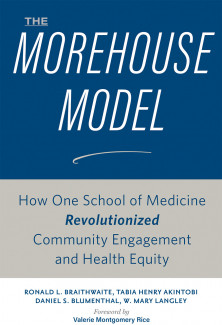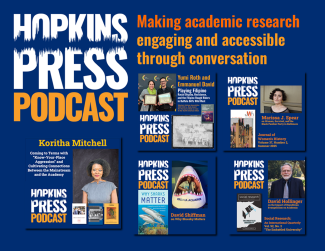
Johns Hopkins UniversityEst. 1876
America’s First Research University
Now Browsing:
The Morehouse Model: How One School of Medicine Revolutionized Community Engagement and Health Equity

This book was written to address the literature and practice gap on effective community engagement strategies in underserved metropolitan, micropolitan, and rural communities, especially in African American communities. The Morehouse School of Medicine (MSM) model of community engagement is an integrated framework based on social science principles and real-time lessons learned. This book, The Morehouse Model, takes you behind the scenes to unfold how integrated strategies from varied health promotion and prevention programs and community-based participatory research contributed to MSM’s preeminence in leading the creation and advancement of health equity. The institution’s global leadership in prioritizing and sustaining community engagement through its number one ranking (among 154 medical schools) in social mission warranted a comprehensive anthology of how this reputation was built, exemplified, and has been scaled over time. The details in this work provide a guiding compass illustrated through a model, case studies, and lessons learned that other academic health centers and health equity proponents may emulate and adapt within their own contexts.
The academic authors have long valued the significance of community intelligence for solving health concerns in concert with communities. The model uses a population science approach to reach the hard-to-reach marginalized and disenfranchised segments of our citizenry. Since inception in 1975, MSM has embraced a creed of genuine partnership with thousands of consumers and community-based organizations. Using a boots-on-the-ground philosophy of going door-to-door to recruit and inspire consumers to engage as leaders in disease prevention and health promotion has been part of the institution’s culture. Thus, being deeply rooted in communities and developing coalition partnerships has sustained MSM’s progress and leadership over time.
The Morehouse Model will serve as a primary textbook for the development of culturally competent community coalitions in health promotion and prevention programming designed to advance health equity and an assumed, lifelong research education and clinical destination. The manuscript is a testimony to the effectiveness of academic-community partnerships to address risk factors contributing to health inequities. The practical strategies, supported by rigorous evaluation, will become the “how-to” in the development and sustaining of community-dominant coalitions to address health and social issues at the grassroots level. We advance that this book will be a guiding compass for burgeoning and seasoned public health, researchers, clinicians, policymakers, and educational leaders seeking to teach, partner, and practice the importance of community-engagement, thus giving voice to the voiceless.

Although grounded in social theories and rigorous evaluation, the simplicity of the model is that the formation of functioning community coalitions is a marathon and not a sprint. Building trust among partners is the fundamental element for successful collaborations. Model implementers must embrace the culture of the target population and that culture is more than race and ethnicity. In the African American community, especially in the rural and micropolitan communities, engaging the faith community will enhance efforts to reach those who are hard-to-reach. Readers will learn what “works” and “does not work” in community engagement to address health and social issues in at-risk populations. The book includes a plethora of coalition development tools and resources.
Community trust, relationships, and collaborations are all built over time, are nuanced and contextually bound. These fundamentals require both art and science, and are the foundation towards building and sustaining community engagement research, clinical practice, education, and genuine service that makes a difference. Community engagement is not solely a means toward traditional ends like grant dollars, academic/peer-reviewed manuscripts, and national/global awards. It is an end unto itself: community ownership in co-creating innovative approaches that improve population health leads to their sustainability thereby advancing health equity.
Order The Morehouse Model: How One School of Medicine Revolutionized Community Engagement and Health Equity -- published on June 16, 2020 -- at the following link: https://jhupbooks.press.jhu.edu/title/morehouse-model
Ronald L. Braithwaite, PhD is a professor of community health and preventive medicine and a professor of family medicine and psychiatry at Morehouse School of Medicine. Tabia Henry Akintobi, PhD, MPH is a professor of community health and preventive medicine, the director of the Prevention Research Center, and the associate dean of community engagement at Morehouse School of Medicine. W. Mary Langley, PhD, MPH is a professor of community health and preventive medicine and the director of the Health Promotion Resource Center at Morehouse School of Medicine. Braithwaite, Akintobi, and Langley, with Daniel S. Blumenthal, MD, MPH (1942–2019), are the co-authors of The Morehouse Model: How One School of Medicine Revolutionized Community Engagement and Health Equity.

The academic authors have long valued the significance of community intelligence for solving health concerns in concert with communities. The model uses a population science approach to reach the hard-to-reach marginalized and disenfranchised segments of our citizenry. Since inception in 1975, MSM has embraced a creed of genuine partnership with thousands of consumers and community-based organizations. Using a boots-on-the-ground philosophy of going door-to-door to recruit and inspire consumers to engage as leaders in disease prevention and health promotion has been part of the institution’s culture. Thus, being deeply rooted in communities and developing coalition partnerships has sustained MSM’s progress and leadership over time.
The Morehouse Model will serve as a primary textbook for the development of culturally competent community coalitions in health promotion and prevention programming designed to advance health equity and an assumed, lifelong research education and clinical destination. The manuscript is a testimony to the effectiveness of academic-community partnerships to address risk factors contributing to health inequities. The practical strategies, supported by rigorous evaluation, will become the “how-to” in the development and sustaining of community-dominant coalitions to address health and social issues at the grassroots level. We advance that this book will be a guiding compass for burgeoning and seasoned public health, researchers, clinicians, policymakers, and educational leaders seeking to teach, partner, and practice the importance of community-engagement, thus giving voice to the voiceless.

Although grounded in social theories and rigorous evaluation, the simplicity of the model is that the formation of functioning community coalitions is a marathon and not a sprint. Building trust among partners is the fundamental element for successful collaborations. Model implementers must embrace the culture of the target population and that culture is more than race and ethnicity. In the African American community, especially in the rural and micropolitan communities, engaging the faith community will enhance efforts to reach those who are hard-to-reach. Readers will learn what “works” and “does not work” in community engagement to address health and social issues in at-risk populations. The book includes a plethora of coalition development tools and resources.
Community trust, relationships, and collaborations are all built over time, are nuanced and contextually bound. These fundamentals require both art and science, and are the foundation towards building and sustaining community engagement research, clinical practice, education, and genuine service that makes a difference. Community engagement is not solely a means toward traditional ends like grant dollars, academic/peer-reviewed manuscripts, and national/global awards. It is an end unto itself: community ownership in co-creating innovative approaches that improve population health leads to their sustainability thereby advancing health equity.
Order The Morehouse Model: How One School of Medicine Revolutionized Community Engagement and Health Equity -- published on June 16, 2020 -- at the following link: https://jhupbooks.press.jhu.edu/title/morehouse-model
Ronald L. Braithwaite, PhD is a professor of community health and preventive medicine and a professor of family medicine and psychiatry at Morehouse School of Medicine. Tabia Henry Akintobi, PhD, MPH is a professor of community health and preventive medicine, the director of the Prevention Research Center, and the associate dean of community engagement at Morehouse School of Medicine. W. Mary Langley, PhD, MPH is a professor of community health and preventive medicine and the director of the Health Promotion Resource Center at Morehouse School of Medicine. Braithwaite, Akintobi, and Langley, with Daniel S. Blumenthal, MD, MPH (1942–2019), are the co-authors of The Morehouse Model: How One School of Medicine Revolutionized Community Engagement and Health Equity.

Login to View & Leave Comments
Login to View & Leave Comments


